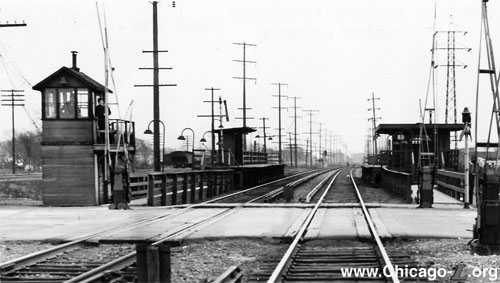|

The 25th Avenue station is seen looking east. The station's wood-frame vernacular design, with some Craftsman elements, is typical of many ground-level "L" stations, particularly others on the Westchester branch. The inbound platform (on the right) features a small station house, while the outbound platform (which had fewer boarding passengers) features only a waiting shelter. The tall building on the left was a gateman's tower to monitor the grade crossing. For a larger view, click here. (Photo from the Graham Garfield Collection)
|
25th Avenue
(2500W/800S)
25th Avenue and Maywood
Drive, Village of Maywood
Service
Notes:

|
Westchester
Line
|
Quick Facts:
Address: TBD
Established: |
August 25, 1902 (AE&C interurban service
inaugurated) |
October 1, 1926 ("L" service
inaugurated) |
Original Line: |
Aurora, Elgin & Chicago Railway (interurban service) |
Metropolitan West Side Elevated, Westchester
branch("L" service) |
Previous Names: Madison Street
Skip-Stop Type: n/a
Rebuilt: circa 1911
Status: Demolished
History:
25th Avenue, originally called Madison Street, opened in 1902 as part of the Aurora, Elgin and Chicago (AE&C) interurban's line between the Fox River Valley and 52nd Avenue in Chicago. A few years later, AE&C trains operated into Downtown Chicago using trackage rights over the Garfield Park branch of the Metropolitan West Side Elevated. 25th Avenue was originally a small, modest station of two low-level side platforms on the east side of the street serving a relatively rural area. The station was rebuilt circa 1911.
In the mid-1920s, the Chicago
Aurora & Elgin interurban planned to build a high-speed
bypass route for their trains through the western suburbs. Designed
to leave the CA&E main line just east of their existing Bellwood station at Bellwood
Avenue, the branch was to go south to Cermak Road, then turn west to
rejoin the CA&E Aurora branch near Warrenville. The only section to be built was what
became the Westchester
branch, which opened as a one-mile spur from Bellwood
Avenue to Roosevelt
Road.
Operation of the Westchester
branch was made the responsibility of the Chicago Rapid Transit
Company, with service beginning on October 1, 1926. The CRT served
the Westchester
branch by extending certain Garfield
Park trains beyond their usual terminal at Desplaines
Avenue. These "L" trains also assumed service to the existing
intermediate stations on the CA&E main line between Desplaines and Bellwood, relieving the interurban of the
obligation to handle this short haul traffic. Upon the inauguration
of "L" service the CA&E ceased serving these stops -- including 25th Avenue station -- except for 5th
Avenue.
When "L" trains began serving the station, the facility consisted of two high-level side platforms on the east side of 25th Avenue. Set back from the street, the platforms were connected to the sidewalk by long walkways with wooden railings. The inbound platform, which had higher boarding traffic, featured a station house on the platform, while the outbound platform, which had more alighting passengers, had only a waiting shelter. The inbound station house was of simple frame design, generally typical
of station houses built along the grade-level
alignments of the "L". The station was a small, wood frame building with clapboard siding and a
flat roof with projecting eaves supported by notched beams. Although strictly vernacular in design, the building had some elements which lent it a vaguely Craftsman influence, similar to other ground-level "L" stations built around the same time such as Harrison on the Westchester
branch. Unlike most ground-level "L" station houses, which were narrow and rectangular, set between the sidewalk and platform, the 25th Avenue station house is square in shape and situated on the platform itself, not requiring passengers to pass through it to access the platform.
The station's high-level platforms hampered the CA&E freight operation's hauling of railroad freight cars, whose width and clearance were often in excess of the "L" and interurban cars resulting in their inability to clear normal high-level "L" platforms. This problem was solved through the ingenious use of hinged flaps along the edges of the platforms, which were flipped up and out of the way by a brakeman riding the locomotive footboards and flipped back down in place by a man riding the caboose steps. This allowed standard-width railroad freight cars to pass the "L" platforms along this portion of the route.
Between February 1941 and November 1942, the CA&E resumed stopping at 25th Avenue. As they did at other "L" stations they served between the west suburbs and downtown Chicago, the interurban only boarded westbound passengers and discharged eastbound passengers so as not to compete with the "L".1
The hoped-for development of Westchester was
squelched by the Depression just a few years after the line opened. The lots sat empty and streets and sidewalks
slowly deteriorated and became overgrown with weeds. There was little
to feed traffic to the fledgling rapid transit line. Development in
Westchester resumed in 1940, but its pace was still slow and
short-lived, as World War II soon struck and once again put a damper
on major construction. The Chicago Transit Authority assumed
operation of the "L" system in October 1947 and soon after
studied each rapid transit
line and monitored each station. Then, bit by bit, the CTA closed the
stations and lines that were most uneconomical and had the lowest
ridership to concentrate on the stronger routes. The Westchester
branch fell victim to this systematic pruning when on December 9, 1951,
service between Desplaines and 22nd & Mannheim was replaced by the #17 Westchester bus route.
After the "L" ceased serving the 25th Avenue station and the rest of Westchester
branch beyond Desplaines, the CA&E interurban resumed stopping in both directions at the station. This continued until July 3, 1957, when passenger service on the CA&E ended without warning to the public at 12:13pm. The station was eventually demolished.
Notes:
1. "25th Avenue." GreatThirdRail.org. Accessed 11 September 2012.



